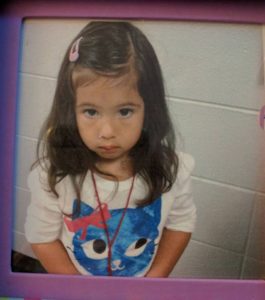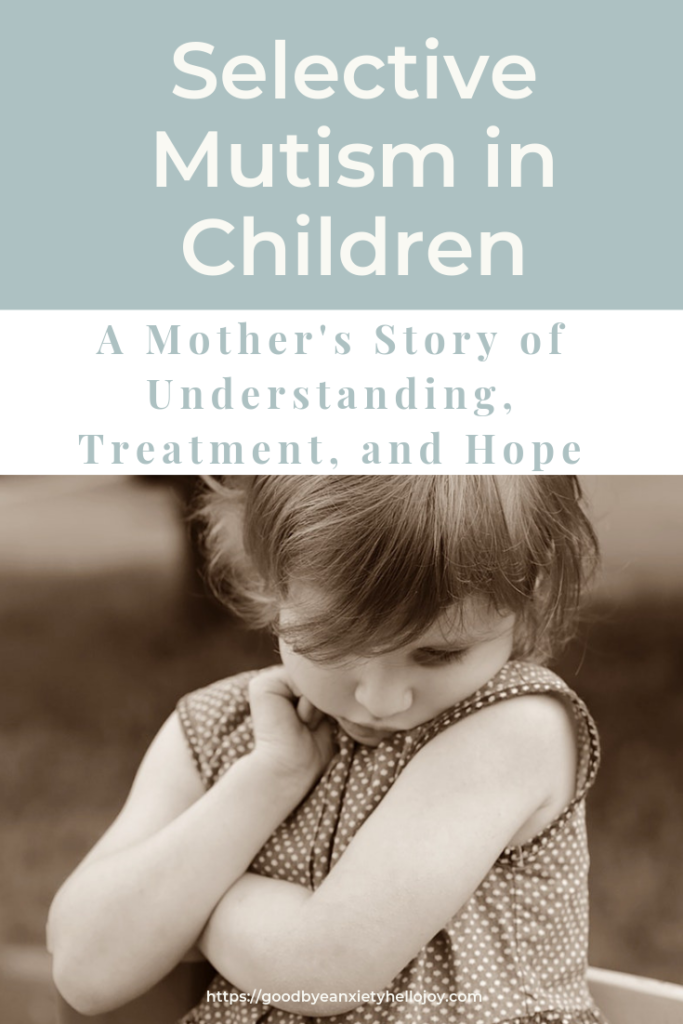Selective Mutism in Children- A Mother’s Story of Understanding, Treatment, and Hope
Incredible thanks to Leslie Peckham for sharing the story of her family’s journey with Selective Mutism in children.
We knew there was something going on that made our daughter afraid and antisocial in certain environments. We just didn’t know it had a name until one day in October of 2015, I literally did a Google search for: “extremely shy child”. At that time, I didn’t know any other way to describe her characteristics and my search brought me to something I had never heard of before: Selective Mutism (SM). I remember being so excited when I read the many characteristics of Selective Mutism in children because it was a way for me to put a name to something that I knew was more than just “shyness”.
More Than “Shyness”
Our daughter Mya is our first-born out of 3. We started noticing things about her, like her avoidance to speak to people or interact with our friends’ kids at parties around 2 ½ years old. We didn’t know why she would act in this way and our frustration with her behavior didn’t make it any better. She could be totally fine and comfortable with people in one situation and then completely frozen and mute with these same people in a different situation.
 We started to think it was just normal developmentally and she would grow out of her shyness. We enrolled Mya in preschool and she didn’t speak to her teacher or classmates her entire 2 years there. She wouldn’t participate in group activities. She never hated going to school and she would never cry. We had that going for us! In fact, she would tell me she had a fun day and then I would see pictures like these from her school day that painted a different picture. I came to realize that she didn’t know how to describe what she was feeling and in her mind, it was all normal and ok.
We started to think it was just normal developmentally and she would grow out of her shyness. We enrolled Mya in preschool and she didn’t speak to her teacher or classmates her entire 2 years there. She wouldn’t participate in group activities. She never hated going to school and she would never cry. We had that going for us! In fact, she would tell me she had a fun day and then I would see pictures like these from her school day that painted a different picture. I came to realize that she didn’t know how to describe what she was feeling and in her mind, it was all normal and ok.
Anxiety is believed to be genetic but the way it manifests is not. Now that I’ve learned more about the signs, I know I had many anxious feelings as a child myself, although I did not have Selective Mutism. As a parent, you question whether it was something you did to cause this and it’s comforting to know that is not the case. Studies have actually shown that the amygdala in the brains of people with anxiety is larger and therefore overactive. The amygdala is the part of our brain that sets out the “fight or flight” response.
Entering Kindergarten Without an Official Diagnosis
In 2015, she entered kindergarten and I don’t recall ever being more nervous for anything in my life. I had been proactive (this was before I had done my Google search and discovered Selective Mutism) and emailed her school to request a teacher who would be compassionate and patient with a student who showed these characteristics. Her very first day of kindergarten, I got a call from the nurse. She had gotten hurt at recess and had a bloody lip but wouldn’t tell anyone what happened. I made the choice to leave her at school for the rest of the day after speaking to the nurse and being reassured that she was not in high distress. She just wouldn’t tell anyone what occurred. She got a great teacher for kindergarten who did all she could to help Mya feel more comfortable.
Mya wouldn’t speak to any of her classmates, but she would sometimes say a few words to her teacher in the hallway away from the class. Her teacher found ways and made time to work with her more one on one so that she could evaluate her. She even came to my house one day to assess her! This was one of the first times Mya’s teacher got to see Mya be a goofball in her environment.
Finally, It All Makes Sense
This moment in our journey brings us to the time of my Google search. I was desperate and feeling very discouraged and didn’t know what to do. I came upon the term “Selective Mutism” and once I was confident this was what we were dealing with, I found a place closest to us called: Advanced Therapeutic Solutions and that is where we went to get her official diagnosis. Once we had a diagnosis, we had so much hope because we knew there was a specific treatment for SM.
Not every child with Selective Mutism is the same. Selective Mutism is an anxiety disorder and many children describe it as feeling like their throat closes up. They have all of these thoughts and ideas in their head, yet they just can’t get the words out. Characteristics such as stiff body movements and flat affect are very common. Some people with Selective Mutism are able to perform in front of others and play silently among their peers. Mya had also been diagnosed with Social Phobia which explains why she could never participate with her peers even without the speaking aspect.

Mya’s kindergarten classmates would ask me why she wouldn’t speak and wanted to know if she could speak. The best way for me to explain it to them was that she was working on being brave enough to speak in front of them and that she does and can speak because she speaks at home all the time. Her kindergarten teacher helped us get an IEP in place for her shortly after her diagnosis and she opened up her classroom to my family to come in as we were able to help Mya.
One thing we did do was plan many playdates with classmates. I wanted her classmates to see that she does speak and will speak when she is comfortable. This was a great way for her classmates to get to know her better. In Mya’s last month of kindergarten, not much progress had been made in terms of speaking in school, even if she had spoken to a classmate in our home.
Finding Help For Selective Mutism in Children
I found a Selective Mutism parent support group in my state of Illinois and started attending those. I think that was one of the most important things for me because it gave me people who can truly relate to our situation and I didn’t feel so alone. It is very isolating because even though people have great intentions, it is a very complex thing to understand and even difficult for some to accept as a real condition. Some people still think that children with SM are just “choosing” not to speak or that it is just something they will outgrow. Now that I know about SM being driven by anxiety, I am happy to make others aware. There is also a group on Facebook called: Parents of Children with Selective Mutism that is very informative and supportive for both parents and even teachers.
Treatment For Our Daughter
We made a very personal decision to start Mya on anxiety medication when we found the studies that showed that this combined with cognitive behavioral therapy had the most success. I am sharing our story and if medication is not something you would ever consider for your child, I am not here to try to change your mind. I knew she needed help with lessening her anxiety and therapy alone was not working. We attended a 5-day intensive therapy session in Michigan with Thriving Minds in May of her kindergarten year. We had researched that this was more effective than weekly therapies and really felt we had to try something. Thriving Minds also accepts some insurances and it just so happened that our insurance was one of them, so we were very excited about this.
During this intensive, we worked on ways to help Mya approach the situations that make her anxious and how to help her through them. We learned that avoidance becomes a cycle. For example: 1) person says hello and asks the child their name 2) child gets anxious and doesn’t answer and an uncomfortable silence follows 3) parent saves the child and answers for them or person asking the question says “oh it’s ok, you’re shy”. Anxiety lessens for everyone in this situation but it doesn’t help the person with the SM to work through it. After our 5-day intensive therapy session, we felt so much better equipped and confident in how to help her.
Mya Talks For the First Time at School
I kid you not, the next day that she returned to school, I joined her for lunch and worked some of my new strategies. She whispered to some classmates at lunch and at indoor recess IN SCHOOL FOR THE VERY FIRST TIME! I was screaming and crying and so happy but this was all going on inside of my head because you quickly learn that bringing attention to the fact that a child with SM does or doesn’t talk is the last thing that will help them. This didn’t stop her classmates from being wide-eyed and telling the others “Mya just talked!” 🙂 I couldn’t blame them one bit. It was such an exciting day for all of us! She finished kindergarten with a few whispers to classmates and speaking to her teacher in semi-private settings.
The summer before first grade we attended Confident Kids Camp at Thriving Minds in Michigan and this is a camp therapy that is set up to simulate a classroom. Each student gets a counselor to work with them one-on-one for the 5 days. The students work on many different tasks like ordering ice cream, scavenger hunts at stores, presenting in front of their “classmates”. All of the activities are based on building the confidence to speak to people and/or in situations that are typically very difficult. This was very helpful in our journey because my hope for Mya in first grade was for her to find at least one friend that she felt comfortable talking to in class. She quickly surpassed my expectations!
She entered first grade running and once again had a wonderful teacher who helped her grow so much! Mya was speaking in full volume to kids at school and also her teacher! She started raising her hand which is huge! With the help of what I learned at Thriving Minds, I was able to set up a big goal for Mya to earn a kitten. Remember I said she surprised us with how fast she took off in first grade? Yes, we didn’t expect that she’d reach her goals so quickly and thought we had more time. Well, she reached her goals and we had to stick to our word! So here is a picture of her presenting to her first-grade class about her cat named “Brave”.
First grade was also the first time Mya smiled in a school picture. Many kids with SM end up with the “deer in headlights” look in front of the camera. Mya’s first-grade teacher set it up for her to be able to go get her picture taken before the rest of the class to lessen some anxiety. We were so lucky to have such caring people all wanting the same thing.
Where We Are Today
 Mya is now in 3rd grade and has improved more and more each year. I wish I could say that she is completely resolved and that SM and was no longer a part of her life. She is doing really well in most situations, and some people who didn’t know her in the past, may not even know this about her. I now do think this may be something she will be dealing with her whole life. What will middle school be like for her? Will she be resolved by then? It rears its ugly head here and there, we see her struggle in many different situations, but she is better able to work through it and she has shown us repeatedly that she is bigger than her fears so it really gives me hope!
Mya is now in 3rd grade and has improved more and more each year. I wish I could say that she is completely resolved and that SM and was no longer a part of her life. She is doing really well in most situations, and some people who didn’t know her in the past, may not even know this about her. I now do think this may be something she will be dealing with her whole life. What will middle school be like for her? Will she be resolved by then? It rears its ugly head here and there, we see her struggle in many different situations, but she is better able to work through it and she has shown us repeatedly that she is bigger than her fears so it really gives me hope!
My advice for those parents who may be reading this who think this sounds like their child is to look up specialists for Selective Mutism in your area. It is worth it to travel if you are able and don’t have anyone local because if they are not experienced with working with Selective Mutism children, you will end up spinning your wheels. Best of luck to you and your child(ren) on your journey! Thank you for reading! Leslie Peckham

My son has SM and we have been recommended medication. Your story is highly inspiring. Could you please share some detail about the medication part ? Like side effects if any, how long the results can be seen after start of medication, can and when it can be discontinued etc. how can I connect you personally?
This article on Selective Mutism was not written by me, as my daughter did not have SM. I can speak about medication she took though for her anxiety and OCD. She took Zoloft with no side effects. I felt it worked well for the mild to moderate anxiety but it did not seem to have any effect on the intense anxiety of OCD. She also tried prozac which seemed effective but led to weight gain. When her anxiety was intense, she tried medications that are stronger than SSRI’s and they all had negative side effects. Currently, as an 18 year old, she is on Lexapro which works very well with no side effects. Of course, this is our experience and each person is different but I truly believe in medication once quality of life is imapcted by anxiety.
My daughter has SM, too..its a tough thing to wrap my head around still. Your story is amazing, I enjoyed reading it